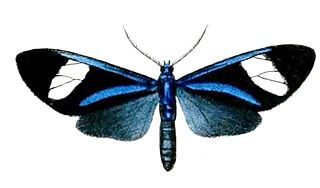Related Research Articles

Lepidoptera is an order of insects that includes butterflies and moths. About 180,000 species of the Lepidoptera are described, in 126 families and 46 superfamilies, 10 per cent of the total described species of living organisms. It is one of the most widespread and widely recognizable insect orders in the world. The Lepidoptera show many variations of the basic body structure that have evolved to gain advantages in lifestyle and distribution. Recent estimates suggest the order may have more species than earlier thought, and is among the four most speciose orders, along with the Hymenoptera, Diptera, and Coleoptera.

Euagra is a genus of moths in the subfamily Arctiinae. The genus was erected by Francis Walker in 1854.

Phostria is a genus of moths of the family Crambidae.
The Global Lepidoptera Names Index (LepIndex) is a searchable database maintained by the Department of Entomology at the Natural History Museum, London.
Euagra angelica is a moth of the subfamily Arctiinae. It was described by Arthur Gardiner Butler in 1876. It is found in Colombia.
Euagra azurea is a moth of the subfamily Arctiinae. It was described by Francis Walker in 1854. It is found in Brazil.
Euagra cerymica is a moth of the subfamily Arctiinae. It was described by Herbert Druce in 1893. It is found in Panama.
Euagra chica is a moth of the subfamily Arctiinae. It was described by George Hampson in 1898. It is found in Bolivia.
Euagra coelestina is a moth of the subfamily Arctiinae. It was described by Caspar Stoll in 1781. It is found in Suriname and the Brazilian state of Pará.
Euagra delectans is a moth of the subfamily Arctiinae. It was described by Schaus in 1911. It is found in Costa Rica.
Euagra fenestra is a moth of the subfamily Arctiinae. It was described by Francis Walker in 1854. It is found in Brazil.
Euagra haemanthus is a moth of the subfamily Arctiinae. It was described by Francis Walker in 1854. It is found in Mexico, Guatemala and Panama.
Euagra intercisa is a moth of the subfamily Arctiinae. It was described by Arthur Gardiner Butler in 1876. It is found in Venezuela.
Euagra klagesi is a moth of the subfamily Arctiinae. It was described by Rothschild in 1912. It is found in Surinam.

Euagra latera is a moth of the subfamily Arctiinae. It was described by Herbert Druce in 1890. It is found in Ecuador and São Paulo, Brazil.
Euagra monoscopa is a moth of the subfamily Arctiinae. It was described by William James Kaye in 1919. It is found in Ecuador.
Euagra perpasta is a moth of the subfamily Arctiinae. It was described by Max Wilhelm Karl Draudt in 1917. It is found in Colombia.
Euagra seraphica is a moth of the subfamily Arctiinae. It was described by Max Wilhelm Karl Draudt in 1917. It is found in Colombia.
Euagra splendida is a moth of the subfamily Arctiinae. It was described by Arthur Gardiner Butler in 1876. It is found in Brazil.
Phostria euagra is a moth in the family Crambidae. It was described by Cajetan Felder, Rudolf Felder and Alois Friedrich Rogenhofer in 1875. It is found in Amazonas, Brazil.
References
| This Arctiinae-related article is a stub. You can help Wikipedia by expanding it. |